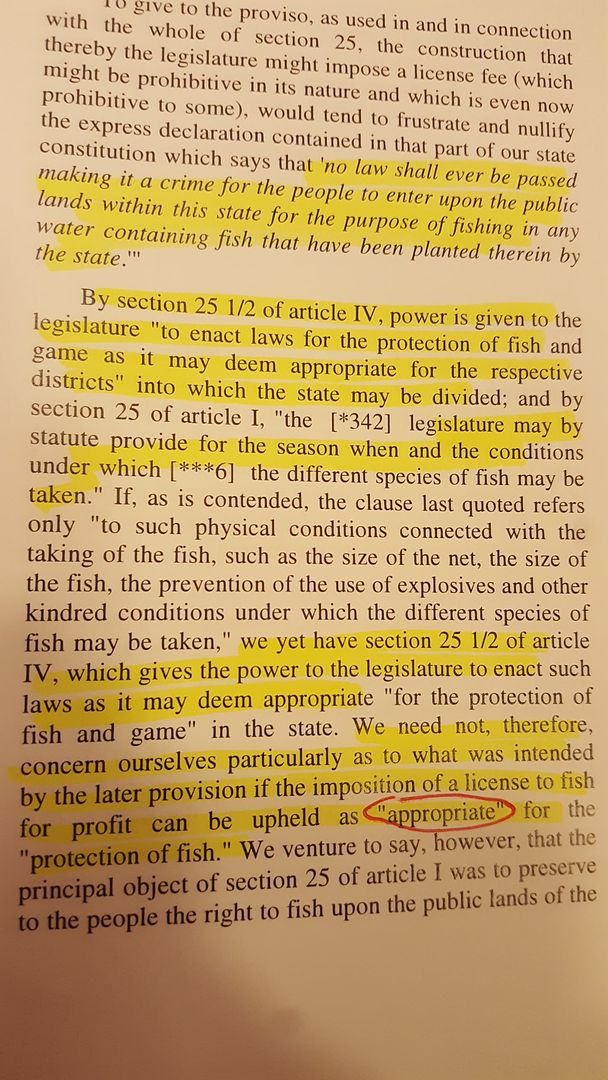
The interpretation of the Supreme Court of CA was that we the people do not have an abolute right to fish by Article 1 section 25.
They concluded that the Fishing License was a protection for the fish and it was upheld.
Case Closed.
https://www.wildlife.ca.gov/Publications/history
Department of Fish and Game celebrates 130 years of serving California
From Outdoor California, November - December 1999
Original Article with Photos (PDF)
In 1970, the Department of Fish and Game turned 100 years old. At that time, a history of significant events over that 100 years was published. A frequently requested item, the history was updated in 1980, and now we have another 20 years to add. We look forward to seeing where fish and wildlife activities lead us in the next millennium. —Editor, Outdoor California Magazine
1849. California Territorial Legislature adopts common law of England as the rule in all state courts. Before this, Spanish and then Mexican laws applied. Most significant legal incident was the Mexican government decree in 1830 that California “mountain men” were illegally hunting and fishing. Captain John Sutter, among others, had been responsible for enforcing Mexican fish and game laws.
1851. State of California enacts first law specifically dealing with fish and game matters. This concerned the right to take oysters and the protection of property rights of persons planting oysters. 1852. First California game law is enacted for 12 counties. It protected elk, antelope, deer, quail, mallard, and wood ducks for six months of each year. Also passed was the first law protecting salmon runs. Enforcement was the responsibility of local authorities.
1854. Game laws are extended to all counties in the state.
1860. The beginning of statewide control. First license act provides that no Chinese or Mongolian could take fish in state waters without a four-dollar monthly license. Collectors of fees were appointed by the governor.
1861. Closed seasons for trout are established.
1869. Lake Merritt (City of Oakland) is made the first state game refuge, believed to be the first in the country.
1870. The Board of Fish Commissioners, forerunner of the Fish and Game Commission, is established “to provide for the restoration and preservation” of fish in California waters. This was the first wildlife conservation agency in the country, even predating the U.S. Commission of Fish and Fisheries. Ca1ifornia’s three “fish commissioners,” appointed by the Governor, received no compensation, but the Legislature appropriated $5,000 to the board for the first two years’ operations. This same year the first fish ladder is built on a tributary of the Truckee River, and a state hatching house is established at the University of California in Berkeley.
1871. First importation of fish-1,500 young shad. Two full-time deputies (wardens) are appointed, one to patrol San Francisco Bay and the other the Lake Tahoe area.
1872. The Legislature passes an act enabling the commission to require fishways or “in-lieu” hatcheries where dams or other obstacles impede or prevent fish passage.
1878. The authority of the Fish Commission is expanded to include game as well as fish.
1879. Striped bass are introduced from New Jersey and planted at Carquinez Strait. 1883. Commissioners establish a Bureau of Patrol and Law Enforcement. Jack London switches sides from oyster pirate to Commission deputy. His forays form the basis for his novel, Tales of the Fish Patrol.
1885. First compilation of California fish and game laws is published. The first fish and game marine patrol is instituted with the placing in operation of the 46-foot patrol boat Governor Stoneman.
1887. Market fishing boats and crews are licensed.
1889. The commission is authorized to import game birds.
1893. The commission engages its first attorney.
1901. After the turn of the century, the administration of fish and game laws was strengthened and expanded. The deputy force reaches 50 men, and the first bag limits are set-deer, three bucks; ducks and doves, 50; quail, 25. Night hunting is outlawed.
1907. First hunting licenses are issued at $1 for everyone hunting certain game birds and animals. Money from the license sale and from fines was credited to the Fish and Game Preservation Fund. The deputy (warden) force expands to 73.
1908. One of the first expenditures from the Preservation Fund is for the establishment of a game farm at Hayward.
1909. Name is changed from the Board of Fish Commissioners to the Fish and Game Commission, which reflects the growing importance of game conservation. The complex fish and game administration of today dates from these years when the commission was given more authority to expand and to undertake new responsibilities. This year marks the last legislative appropriation for fish and game administration. Commercial licenses for fishermen are inaugurated (commercial fishing boats had been licensed in 1887).
1913. The first general angling license ($1) is required for all persons over 18. A law is adopted prohibiting the taking of the endangered sea otter. The first field study of duck disease (botulism) is conducted.
1914. The Commission creates the Bureau of Education, Publicity and Research because of the need for development in these areas. Publication of a quarterly journal, California Fish and Game, starts.
After all this researching, i never want to see this case law again
I am surprised that the anglers who stood up were able to stop MLPA from taking everything,
this is how much power they have to protect the fish.